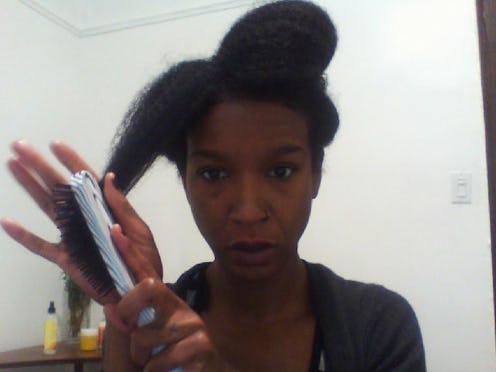
After my own big chop years ago, I ditched many styling tools that I simply had no need for: My flat iron was bequeathed to a good friend's bangs, all shampoos and conditioners were poured down the drain, and of course, my brush went straight in the trash. For someone who used to break a brush in every three months when it was time for a new relaxer, I naively assumed that brushing natural hair would be a hair don't.
My hesitance to brush my afro was largely due to the fact that I was sure it would break my hair. In fact brushing natural hair is a popular detangling method that many kinky folks swear by. One of the best reasons to brush is that it saves time on those brutal detangling sessions. When I first took to a carefully chosen brush, I noticed that those annoying tangles that were previously impossible to get rid of came out fairly quickly — and without even a drop of frustration tears. Real talk though: The Brush can be your best friend or your worst enemy. Choosing the right brush and method will no doubt involve some trial and error — but it's worth it.
If you are looking for a new detangling method or just a big afro without applying heat, follow these helpful hints for the best brushing results on your natural hair.
1. Choose The Right Brush For Your Curl Pattern
Denman Brush, $18, Amazon
The most overwhelming part about introducing a brush into my hair routine was choosing the right one. My hair is incredibly nappy in the back, so I wanted a brush that had at least six rows of bristles with a decent amount of space between them. Most naturals stand by the Denman Brush for their detangling techniques, but I purchased a knock-off and have been pretty happy with the results. So how do you know if you are using the right brush? The hair left behind will tell you!
2. Section Your Hair
The easiest way to rip your hair and break your brush is to blindly try to run your new brush through your mane. Section your hair so you can work through each section making sure you are getting all the snags and tangles out.
3. Get Your Hair Ready For Detangling
Leave in Conditioner, $16, Amazon; Coconut Oil, $24, Amazon; Shea Natural, $22, Amazon
If dry detangling methods aren't your jam, then you definitely want to make sure you get your hair properly lubed up for your brushing session. I never detangle my hair soaking wet, but always on damp hair with a proper leave-in conditioner or homemade hair butter.
4. Finger Detangle First
If you haven't detangled in a while and you know that those curls are a nappy mess, it's best to finger detangle each section quick to work out the bigger tangles that can be saved. This is crucial for keeping hair loss at a minimum.
5. Start From The Ends and Brush Upwards
This is a hard habit for me to get into; when I had relaxed hair I always brushed from top to bottom. It's incredibly important to start from the ends for naturals, since the ends are where your hair traps the curls that you naturally shed. You'll notice the ends of your hair tend to be more tangled and as you work your way up to the top of the section you should be able to run the brush completely through your hair without stopping.
6. Go Slow
The last thing you ever want to do is rush a detangling session, especially when using a brush. Brushing slowly keeps hair breakage at a minimum and it will stop you from pulling the root of your hair.
7. Style Accordingly
I usually will put my hair in twists and keep a hat on for the day because often wearing my afro out immediately just means I'll be detangling again tomorrow. Obviously, it's going to be hard to resist wanting to wear your fluffy 'fro immediately.
Image: Klaus Post/Luc B/Flickr; Giphy; Kristin Collins Jackson